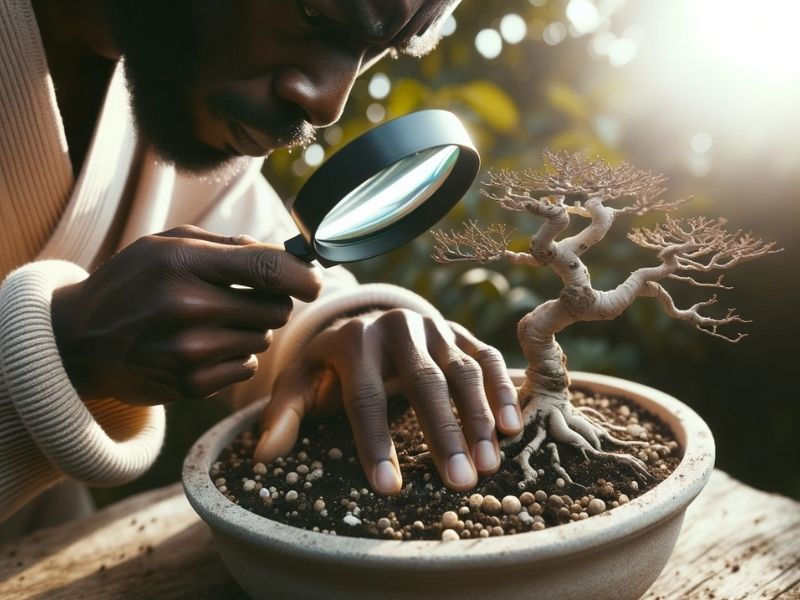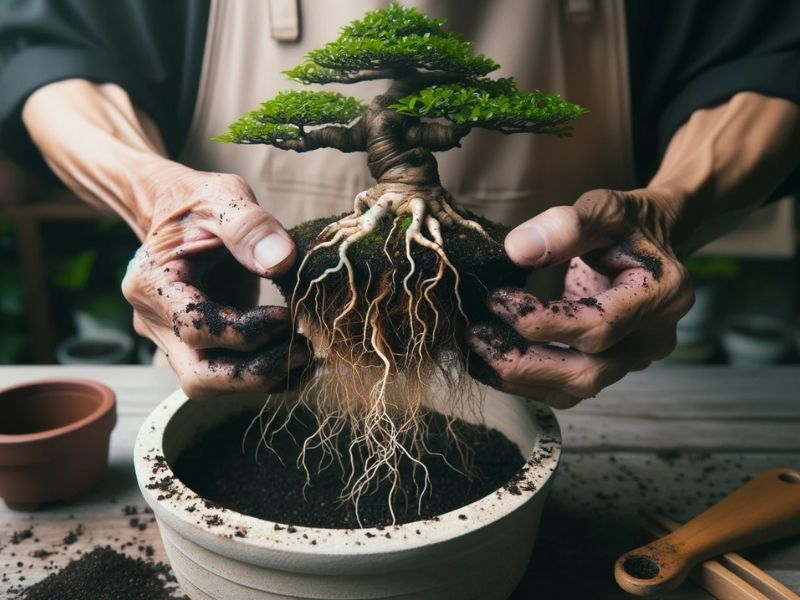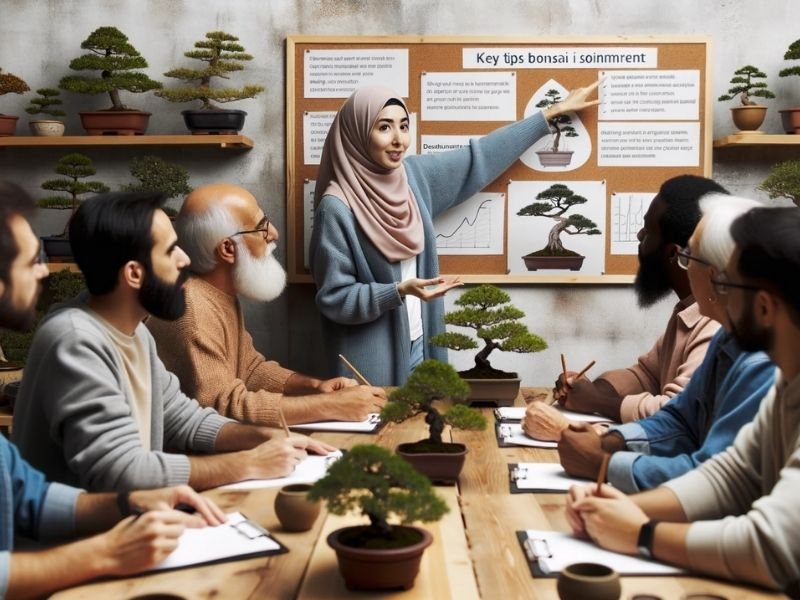Bonsai soil maintenance is pivotal in ensuring the thriving cultivation of these miniature trees. Bonsai, an art form with ancient roots, relies heavily on the balance of nutrients, aeration, and drainage provided by the soil.
This introductory guide sheds light on why maintaining the quality and health of the soil is integral to achieving the aesthetic and vitality that bonsai enthusiasts aspire for.
As we delve deeper into this topic, readers will gain a comprehensive understanding of various practices and techniques to keep their bonsai flourishing for years to come.
Bonsai Soil Maintenance: Aeration, Repotting, And Refreshing
Bonsai trees, diminutive yet brimming with ancient symbolism and aesthetic beauty, hinge on the trifecta of proper soil maintenance: aeration, repotting, and refreshing. Each of these practices serves as a pillar, supporting the overall health, growth, and longevity of these delicate trees.
Aeration
Is the practice of ensuring that the bonsai soil is permeable enough to allow fresh air to penetrate, essential for a healthy root system. Without adequate aeration, a bonsai tree’s roots can become susceptible to diseases like root rot. Proper aeration also promotes robust root growth, anchoring the tree firmly and providing access to vital nutrients.
Repotting
Is the process of transferring the bonsai tree to another pot, often with fresh bonsai soil mix. This technique serves multiple purposes. Over time, the tree’s roots can grow so much that they begin to circle the inside of the bonsai pot, constricting their own growth – a phenomenon known as being “root-bound“. Repotting ensures the root ball remains healthy, giving the bonsai tree room to grow and breathe.
Refreshing
The soil ensures the bonsai continues to receive a rich supply of essential nutrients. Bonsai soils, especially good quality bonsai soil, can deplete over time, losing their nutritional richness. Refreshing the soil mix not only revives the nutrient content but also improves drainage and aeration, critical for the tree’s optimal growth.
In the maintenance of bonsai soil, these three elements are interconnected. They each play a pivotal role in ensuring that bonsai trees, regardless of their tree species, flourish in their miniature landscapes, reflecting the harmony and balance this art form seeks to encapsulate.
Proper understanding and execution of these practices lay the foundation for a thriving bonsai, capturing the essence and vitality of nature in a small pot.
Aeration In The Maintenance Of Bonsai Soil: Ensuring Root Vitality

In the intricate world of bonsai cultivation, ensuring the vitality of a bonsai tree’s root system is paramount. A critical component of this vitality is aeration.
Proper aeration of bonsai soil ensures that the roots have access to the fresh air they desperately need. Without it, the soil becomes a breeding ground for unwanted pathogens and can lead to various complications, including root rot.
Importance Of Aeration
Root rot is a dreaded condition in which the tree’s roots become infected due to excess moisture and lack of fresh air in the soil. The presence of this condition can be detrimental to the bonsai tree, stunting its growth and even leading to its demise.
On the flip side, good aeration promotes robust root growth, enabling the bonsai tree to absorb essential nutrients from the soil mixture and ensuring stability.
Identifying Signs Of Poorly Aerated Bonsai Soil
Recognizing the signs of poorly aerated soil is crucial. One of the most evident signs is water pooling on the soil surface, indicating poor drainage. If the bonsai soil feels compacted or hard to the touch, it’s another telltale sign. Foul odors emanating from the soil can also be indicative of anaerobic conditions, which are harmful to the bonsai tree’s roots.
Techniques And Tools For Enhancing Soil Aeration
- Soil Mixes: Using a correct soil mixture, like incorporating inorganic soil components such as perlite or pumice, can greatly improve aeration. These elements create pockets of air, ensuring that the tree’s roots receive adequate oxygen.
- Root Pruning: Regularly pruning the bonsai’s roots prevents them from becoming too dense, promoting better airflow and preventing root ball compaction.
- Soil Probing: Tools like soil probes or chopsticks can be gently inserted into the soil to create small channels, enhancing aeration without disturbing the roots.
- Repotting: As mentioned before, repotting not only provides room for growth but also offers an opportunity to refresh and aerate the soil mix.
Repotting As A Key Bonsai Soil Maintenance Technique

Repotting is a ritual in the bonsai tradition, a necessary act that ensures the bonsai tree’s longevity, health, and continued growth.
The bonsai pot is not just a container; it’s an integral part of the bonsai’s environment, and over time, it may need change and renewal.
Reasons Behind Repotting Bonsai Trees
- Root Health: As bonsai trees grow, their roots can fill up the container, leading them to become “root-bound.” This restricts the tree’s roots, preventing them from expanding and accessing nutrients, which can stunt growth and even harm the tree.
- Soil Depletion: Over time, the nutrients in the bonsai soil mix can be exhausted. Repotting allows for the introduction of fresh, nutrient-rich soil, ensuring the bonsai continues to receive the sustenance it requires.
- Tree Growth: Bonsai trees, despite their miniature stature, continue to grow. As they expand in size, a larger bonsai pot may be required to accommodate this growth.
- Disease Prevention: A fresh start with new soil can help in eliminating pests or diseases that may have taken residence in the old soil.
Ideal Frequency For Different Tree Species
- Deciduous Trees: These typically need repotting every 2-3 years. Younger trees, with faster growth rates, might need more frequent repotting.
- Conifers: Depending on the species, conifers might be repotted every 3-5 years.
- Tropical Species: Owing to their rapid growth in ideal conditions, tropical bonsai might need repotting annually or every two years.
Preparing Bonsai Pot, Root Ball Management & Soil Selection
- Pot Preparation: Ensure the bonsai pot is clean, free of debris, and has adequate drainage holes. Sometimes, a wire mesh is placed over these holes to prevent soil loss and to anchor the tree.
- Managing the Root Ball: Gently remove the bonsai tree from its current pot. Using specialized tools, prune away any dead or excessively long roots. This not only manages the size of the root ball but also promotes healthy root growth.
- Selecting the Correct Soil Mixture: Depending on the tree species, the correct soil mixture can vary. A mixture of organic soil and inorganic soil components is often ideal. For instance, deciduous trees might benefit from a soil mixture with a higher organic matter content, while conifers might prefer a grittier mix.
Refreshing The Soil: A Crucial Step In The Maintenance Of Bonsai Soil.

The soil in which a bonsai tree is planted is not just a medium; it’s the lifeblood providing essential nutrients and support.
Over time, like any natural resource, it can become depleted. Recognizing when and how to refresh this soil is fundamental to the ongoing health of the bonsai.
Recognizing Depleted Bonsai Soil
- Change in Soil Texture: If the soil starts feeling compacted or loses its friability, it’s a sign that it might need refreshing.
- Reduced Water Drainage: Poor drainage, with water pooling on the soil surface, is a clear indicator of soil depletion.
- Stunted Growth: If the bonsai tree’s growth slows down or its leaves begin yellowing despite adequate care, the soil may lack essential nutrients.
Distinctions Among Different Soil Types
- Garden Soil: This is the general soil found in gardens, often dense and rich in organic matter. While it’s fertile for garden plants, it’s typically too heavy and compact for bonsai trees.
- Potting Soil: Designed for potted plants, this soil has better drainage than garden soil. However, it might still not offer the ideal aeration and drainage required for bonsai.
- Bonsai Soil Mixes: These are specialized mixes designed for bonsai trees. They contain a balance of organic soil and inorganic soil components, ensuring optimal drainage, aeration, and nutrient content.
Integrating Organic and Inorganic Soil Components
- Organic Matter: This includes elements like pine bark or compost. They provide essential nutrients and retain moisture, which is crucial for the bonsai’s growth.
- Inorganic Soil: Components like akadama, perlite, or pumice not only help in aeration but also aid in drainage, preventing conditions like root rot. They also contribute to the soil’s structural stability, ensuring the bonsai tree remains anchored.
Refreshing the soil is not merely a step; it’s an art in itself. With refreshed soil, a bonsai can continue to flourish, embodying the delicate balance between nature and nurture.
Soil Varieties: Tailoring Bonsai Soil Maintenance To Your Tree’s Needs
Every bonsai tree, with its unique characteristics and requirements, demands a tailored approach to soil maintenance. Just as no two bonsai trees are the same, their soil needs vary based on species and climatic conditions.
To nurture a bonsai tree to its full potential, understanding these soil varieties and customizing them to the tree’s needs is essential.
Differences In Soil Needs Based On Tree Types
Deciduous Trees
These trees shed their leaves annually and typically have a robust root growth. Their soil needs to be nutrient-rich, with a good blend of organic matter like compost or pine bark. Adequate aeration is crucial, and the soil mix should ensure moderate moisture retention.
Conifers
These evergreen trees, including pines and junipers, have different root behaviors compared to deciduous trees. They thrive in well-draining soil. A gritty mix, rich in inorganic soil components like akadama or pumice, is ideal. However, a smidgeon of organic matter ensures they get their nutrient dose.
Tropical Species
Native to humid and warm climates, these bonsai trees require soil that retains moisture without becoming waterlogged. A blend that balances organic soil, for nutrient content and moisture, with inorganic elements for aeration, is best suited.
Customizing Bonsai Soil Mixes
- Analyzing Tree Needs: Before deciding on a soil mix, assess the tree’s natural habitat and growth rate. A fast-growing tropical bonsai might need more frequent soil replenishment than a slow-growing conifer.
- Experimentation: Often, the best bonsai soil mix comes from experimenting. Start with a basic mix tailored to the tree species and adjust based on the tree’s response. Over time, this iterative process will yield the perfect blend.
- Incorporating Special Components: Depending on the bonsai tree species, certain soil components might be beneficial. For instance, adding sand or grit can enhance drainage for species that are sensitive to overwatering.
- Seasonal Adjustments: Trees’ needs can change with seasons. For instance, during growth phases, a soil richer in organic matter might be beneficial, while dormant phases might require a focus on drainage.
By tailoring the maintenance of bonsai soil to the specific needs of each tree species, one can ensure that the bonsai remains a testament to nature’s beauty and resilience.
Tips And Recommendations For Effective Bonsai Soil Maintenance

For anyone new to the art of bonsai, the vast array of soil types, components, and maintenance techniques can feel overwhelming. However, with a clear understanding and the right guidance, ensuring the health and vitality of your bonsai through proper soil maintenance becomes an enjoyable and rewarding process.
Guidance For Beginners On Bonsai Soil Selection And Preparation
- Start with Quality: Always invest in good quality bonsai soil from a reputable supplier. While it might be tempting to use regular garden soil or generic potting soil, remember that bonsai trees have specific needs that only specialized soil mixes can cater to.
- Understand Soil Components: Familiarize yourself with both organic and inorganic soil components. Organic matter like pine bark or compost provides essential nutrients, while inorganic elements like akadama or pumice ensure proper aeration and drainage.
- Pre-Screening: Before using any soil mixture, it’s advisable to screen it to remove overly fine particles. This process ensures better aeration and prevents soil compaction, critical for healthy root growth.
- Research Your Bonsai Species: Each bonsai tree species has its unique soil requirements. Do thorough research or consult with experts to understand what will work best for your specific tree.
Top Recommended Soil Mixes & Tips For Different Tree Varieties
- Deciduous Trees: A mix of 60% organic soil (like compost) and 40% inorganic (like akadama) tends to work well. Ensure regular watering but avoid oversaturation.
- Conifers: A gritty mix, comprising 70% inorganic components and 30% organic matter, is recommended. Monitor moisture levels closely, especially during growth phases.
- Tropical Species: A balanced 50-50 mix of organic and inorganic components can be ideal. However, always ensure proper drainage to prevent root rot.
- Adjusting for Climate: If you live in an area with heavy rainfall, increase the inorganic component for better drainage. Conversely, in drier climates, a higher percentage of organic matter can help retain essential moisture.
- Regular Refreshing: Over time, even the best soil can become depleted. Recognize the signs, whether it’s slowed growth or poor water drainage, and refresh your soil mixture accordingly.
With the right knowledge, patience, and passion, every bonsai enthusiast can master the nuances of soil maintenance, ensuring that their miniature trees flourish and thrive for years to come.
The Symbiotic Relationship: Bonsai Soil Maintenance’s Ultimate Goal
The world of bonsai, with its minute attention to detail, is as much about harmony and balance as it is about aesthetics. One of the most profound aspects of this art form is the symbiotic relationship between the bonsai tree, its root system, and the soil it thrives in.
This relationship forms the foundation for the bonsai’s health, vitality, and visual splendor.
The Bonsai Tree And Its Connection To The Soil
- Nourishment and Support: At its core, the soil provides the bonsai tree with essential nutrients. Every granule of organic matter, from compost to pine bark, breaks down to feed the tree, ensuring it has the energy to grow and flourish.
- Drainage and Aeration: The unique structure of bonsai soil, often a mix of organic and inorganic components, ensures that the bonsai tree’s roots receive fresh air, vital for preventing root rot and promoting root growth. This is where inorganic components, such as pumice or akadama, play a crucial role, providing spaces for air and facilitating effective drainage.
Root System: The Bonsai’s Lifeline
The root system is where the magic truly happens. It’s through the tree’s roots that water and nutrients are absorbed. A healthy root system is indicative of a healthy bonsai.
The key to this health lies in:
- Root Pruning: Occasionally, to maintain the bonsai’s size and health, the root ball needs to be pruned. This practice not only helps in shaping the bonsai but also encourages the growth of finer roots, which are more efficient at absorbing nutrients.
- Protection from Diseases: By maintaining a well-aerated soil and avoiding over-watering, the chances of root diseases like root rot are significantly diminished.
Harmony: The Dance Between Bonsai, Roots, And Soil
- Responsive Care: The bonsai communicates its needs through its leaves, trunk, and overall health. Yellowing leaves might indicate a lack of nutrients, while wilting could be a sign of overwatering. By being attuned to these signs and understanding the symbiotic relationship, bonsai enthusiasts can adjust their care regimen accordingly.
- Evolution with Time: As the bonsai grows, its needs evolve. What was once the perfect soil mix might need adjustments. The tree’s roots might outgrow the bonsai pot. Being aware of and responsive to these changes is key to maintaining the harmony.
The art of maintenance of bonsai soil is not just a task or a routine. It’s a journey into understanding the deep, symbiotic relationship between the tree and its environment. Through diligent care, observation, and a touch of love, bonsai enthusiasts can foster this relationship, ensuring that their miniature masterpieces remain a testament to nature’s profound beauty and intricate balance.





0 Comments